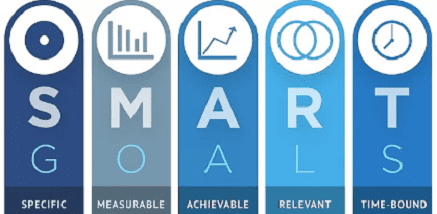1. What are SMART Goals?
SMART is an acronym that stands for Specific, Measurable, Achievable, Relevant, and Time-bound. It's a widely used goal-setting framework in various fields, including business management.

2. Benefits of Building SMART Goals
SMART goals offer a multitude of benefits for businesses, including:
-
Enhanced Focus and Commitment: When goals are clearly defined and specific, individuals and departments within the organization can easily focus their efforts and commit to achieving the common objectives.
-
Improved Operational Efficiency: SMART goals enable businesses to measure progress and effectiveness, allowing them to adjust strategies and operations accordingly to achieve their goals.
-
Increased Goal Attainment: SMART goals are designed based on practicality and have specific deadlines, boosting the likelihood of goal accomplishment.
-
Motivated Workforce and Morale: As goals are broken down into smaller, achievable milestones, employees feel more motivated and have higher morale.
3. How to Build SMART Strategic Goals for Businesses

To build SMART strategic goals for your business, follow these steps:
Step 1: Define the Overall Goal
The overall goal is the company's overarching objective for a specific period. It should be aligned with the company's vision, mission, and strategic direction.
Example: The company's overall goal for the next 5 years is to become the leading tourism service provider in Vietnam.
Step 2: Break Down the Overall Goal into Smaller Goals
The overall goal is often too broad and difficult to measure. Therefore, you need to break it down into smaller, more specific, and achievable goals.
Example: The company's overall goal of becoming the leading tourism service provider in Vietnam can be broken down into smaller goals such as:
- Increase domestic tourism revenue by 20% annually for the next 5 years.
- Expand the tourism market to 5 new countries within 3 years.
- Enhance customer satisfaction levels to 90% within 2 years.
Step 3: Ensure Specificity
Goals need to be specific, clear, and well-defined. Answer questions like: What is the goal? Who will achieve the goal? When is the goal to be achieved? Where is the goal to be achieved? To what extent is the goal to be achieved?
Example: The goal of "Increasing tourism revenue" should be refined to "Increasing domestic tourism revenue by 15% and international tourism revenue by 25% annually for the next 5 years."
Step 4: Ensure Measurability
Goals need to be measurable to track progress and evaluate performance. Identify specific metrics and indicators that align with the goal.
Example: The goal of "Increasing domestic tourism revenue by 15% and international tourism revenue by 25% annually for the next 5 years" can be measured by metrics such as:
- Domestic and international tourism revenue for each year.
- Annual growth rate of domestic and international tourism revenue.
Step 5: Ensure Achievability
Goals should be realistic and achievable based on the company's capabilities. Consider factors such as resources, financial capacity, human capital, market conditions, etc., to ensure the goal is attainable.
Example: The goal of "Increasing domestic tourism revenue by 15% and international tourism revenue by 25% annually for the next 5 years" needs to be assessed based on factors such as:
- Demand for domestic and international tourism.
- The company's competitive landscape.
- Management and employee capabilities.
- Financial resources.
Step 6: Ensure Relevance
Goals should align with the overall business strategy and be consistent with the company's vision and mission.
Example: The goal of "Increasing domestic tourism revenue by 15% and international tourism revenue by 25% annually for the next 5 years" should be aligned with the company's overall goal of becoming the leading tourism service provider in Vietnam.
Step 7: Ensure Time-Boundness
Goals need to have a specific deadline to enable progress tracking and performance evaluation. Set a start and end date for each goal.
Example: The goal of "Increasing domestic tourism revenue by 15% and international tourism revenue by 25% annually for the next 5 years" should have a specific time frame, such as from 2024 to 2028.
Example of Building SMART Strategic Goals for a Business
ABC Company is a toy manufacturer and distributor operating in Vietnam. The company is developing a 5-year strategic plan with the goal of becoming the leading toy provider in Vietnam.
Based on its overall strategy, ABC Company has established specific SMART strategic goals as follows:
Goal 1: Increase annual sales revenue by 20% for the next 5 years.
Measurable Indicators:
- Annual sales revenue
- Annual sales growth rate
Achievability Factors:
- Growing demand for toys in the Vietnamese market
- ABC Company's strong brand reputation and high-quality products
- Dynamic and creative workforce
- Ample financial resources
Relevance Factors:
- Aligned with the company's overall goal of becoming the leading toy provider in Vietnam
- Enhances the company's competitive edge
- Contributes to increased profitability and market share
Timeframe:
- From 2024 to 2028
Goal 2: Expand the market to 3 new countries within 3 years.
Measurable Indicators:
- Number of countries ABC Company exports to
- Export revenue to new markets
Achievability Factors:
- Growing demand for toys in new markets
- ABC Company's high-quality products tailored to the preferences of consumers in new markets
- Extensive distribution network in new markets
Relevance Factors:
- Aligned with the company's overall goal of becoming the leading toy provider in Vietnam
- Expands market reach and revenue streams
- Enhances the company's international presence
Timeframe:
- From 2024 to 2028
Goal 3: Enhance customer satisfaction levels to 90% within 2 years.
Measurable Indicators:
- Customer satisfaction rate
- Number of customer complaints
- Number of positive customer reviews
Achievability Factors:
- ABC Company's high-quality products and excellent customer service
- Dedicated and customer-centric workforce
- Effective customer relationship management system
Relevance Factors:
- Aligned with the company's overall goal of becoming the leading toy provider in Vietnam
- Enhances customer loyalty and attracts new customers
- Contributes to a positive brand reputation
Timeframe:
- From 2024 to 2028
Conclusion
SMART goals are an effective tool for businesses to develop and implement successful strategic plans. By applying the SMART framework, companies can establish specific, measurable, achievable, relevant, and time-bound goals, increasing the likelihood of goal attainment and enhancing overall business performance.
Call to Action
Do you want to build SMART strategic goals for your business? Contact KPIBSC.com today for a free consultation and support. With our team of experienced professionals and comprehensive solutions, KPIBSC.com will help you craft effective strategies and achieve your business objectives swiftly and efficiently.
KPIBSC.com - The leading business management and digital transformation platform in Vietnam.
Website: https://kpibsc.com/
Sign up for KPIBSC.com's service package today to embark on your digital transformation journey and achieve sustainable growth!